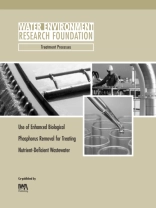Anaerobic/aerobic (An A) and completely aerobic (CA) laboratory-scale sequencing batch reactors operating on an acetate- and casamino acids-based synthetic wastewater were used to investigate the suitability of the An A process for treating nutrient?deficient wastewaters in plants that have stringent effluent nutrient requirements. Of particular interest is the case where phosphorus (P)-deficient wastewaters with highly variable influent COD loading are being treated to meet both effluent TSS and P limits. At a 4 d mean cell residence time, An A activated sludge had an approx. 20% lower P requirement than CA activated sludge. The difference between the end-of-aerobic cycle polyhydroxyalkanoate and carbohydrate contents of the sludges indicated that the An Asludge used more influent carbon than the CA sludge for synthesis of non-P-containing storage products. The nitrogen requirements of An A sludge were similar to those of the CA sludge. The An A and CA SBRs were subjected to three different transient influent COD loading patterns that simulated (#1) daily COD Loading fluctuations, (#2) low weekend COD loading, and (#3) extended low COD loading periods. During the Loading Pattern #1 experiment, the average effluent soluble P concentrations for the An A and CA SBRs were 0.4 and 1.0 mg P/L respectively, and complete removal of influent acetate was observed. During the Loading Pattern #2 experiment, the average effluent soluble P concentrations for the An A and CA SBRs were 0.3 and 0.9 mg P/L respectively, but effluent acetate was detected during the first high COD loading cycle following the low weekend COD loading period. During the Loading Pattern #3 experiment, the VSS content of both reactors dropped sharply, effluent acetate breakthrough occurred, and effluent P concentrations exceeding 1 mg P/L were detected in both the An A and CA SBRs. Based on these findings, the An A process has potential as a technologically and economically superior alternative for wastewater treatment plants treating P-deficient wastewasters to meet stringent effluent TSS and P limits. This publication can also be purchased and downloaded via Pay Per View on Water Intelligence Online – click on the Pay Per View icon below
Format PDF ● Pages 129 ● ISBN 9781780404097 ● Publisher IWA Publishing ● Published 2004 ● Downloadable 6 times ● Currency EUR ● ID 5760647 ● Copy protection Adobe DRM
Requires a DRM capable ebook reader












